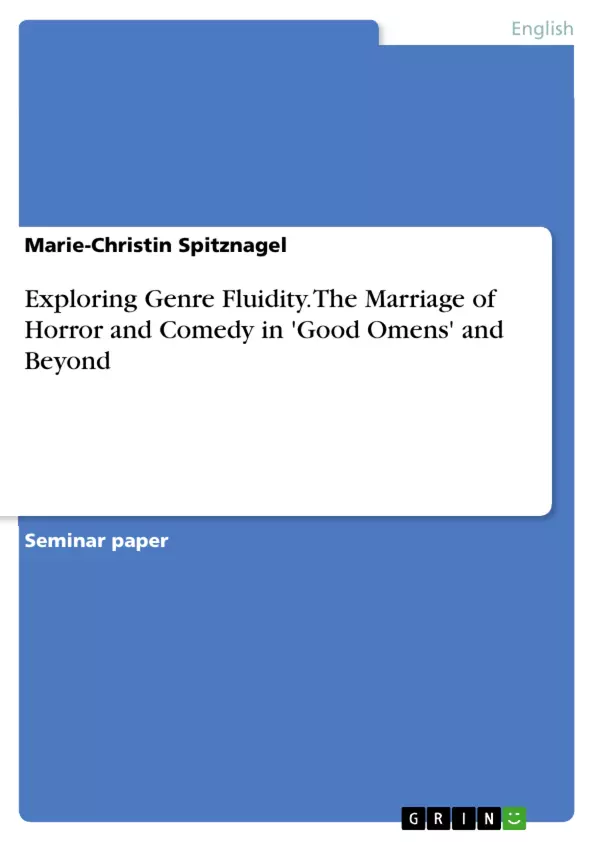This study focuses on the exploration and intersection of genres in literary works and their adaptations, as exemplified by Terry Pratchett and Neil Gaiman's novel and TV series "Good Omens". The paper questions existing genre boundaries and demonstrates how the intentional transgression of these confines broadens creative space, leading to extraordinary works.
In the specific case of "Good Omens", the successful melding of the seemingly contradictory genres of horror and comedy is analyzed. The aim of this paper is to understand how the authors effectively utilize genre conventions and tropes of both horror and comedy, thereby creating a unique literary piece that cannot strictly be assigned to one genre.
The first part of the paper focuses on the differences and similarities of horror and comedy and illuminates the theory and practice of both genres. The second part applies these theories to "Good Omens", examining how horror and humor are used and intertwined in the work.
Inhaltsverzeichnis (Table of Contents)
- Introduction
- Similar but different
- The two genres in theory and practice
- A fine way to scare your reader
- The high art of Comedy
- Harmless or dangerous?
- How Horror and Comedy work together
- Horror and Humour in Good Omens
- The horrific story of the boy Adam
- How to break the tension
- Conclusion
Zielsetzung und Themenschwerpunkte (Objectives and Key Themes)
This term paper aims to examine the intersection of horror and comedy, two seemingly contradictory genres, within the context of Terry Pratchett and Neil Gaiman's Good Omens. The paper explores the use of common tropes and conventions from multiple genres, particularly horror and comedy, in this work. It focuses on how these genres, despite their seemingly opposing nature, can effectively complement and enhance each other, drawing upon examples from literature and film.
- Genre boundaries and their transgression
- The interplay of horror and comedy
- The use of tropes and conventions in both genres
- The evolution of the horror genre and its connection to audience fears
- The influence of Christian mythology on horror and comedy
Zusammenfassung der Kapitel (Chapter Summaries)
The introduction explores the concept of genre and how boundaries are often blurred in works that defy categorization. The paper uses Good Omens as an example of a work that transcends genre boundaries, drawing from elements of apocalyptic fiction, fantasy, and science fiction. It highlights the theoretical framework of structuralism and post-structuralism, which offer contrasting perspectives on genre.
Chapter 2 delves into the theoretical underpinnings of horror and comedy. It provides a historical overview of both genres, tracing their development from early Gothic fiction to contemporary works. It discusses the nature of fear and its role in the horror genre, emphasizing how the genre constantly evolves to reflect contemporary societal anxieties. Additionally, it explores the relationship between horror and humor, emphasizing how the comedic element can arise from the absurdity of fear.
Chapter 3 focuses on the specific use of horror and comedy in Good Omens. It examines how the narrative incorporates elements of both genres, particularly in relation to the character of Adam. It analyzes how the authors use these genres to create a unique and engaging reading experience.
Schlüsselwörter (Keywords)
The key focus topics of this term paper include genre theory, horror, comedy, Good Omens, Terry Pratchett, Neil Gaiman, apocalyptic fiction, tropes, conventions, and Christian mythology. The paper examines the intersection of these concepts within the context of a specific literary work, exploring the creative potential of genre transgression and the relationship between seemingly contrasting genres.
- Citar trabajo
- Marie-Christin Spitznagel (Autor), 2021, Exploring Genre Fluidity. The Marriage of Horror and Comedy in 'Good Omens' and Beyond, Múnich, GRIN Verlag, https://www.grin.com/document/1361701



